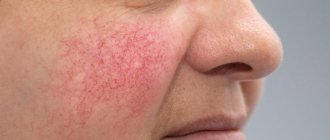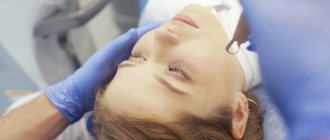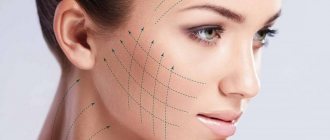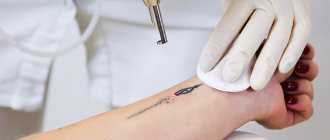Is it possible to get rid of blood vessels forever?
Under the influence of various aggressive factors (frequent visits to baths and saunas, excessive alcohol consumption, harsh weather conditions - extreme heat, cold, stress) - due to increased pressure in the vascular bed, neighboring vessels may begin to appear again. Unfortunately, cosmetology does not fight the cause of blood vessels, but only the aesthetic manifestations. The cause of the appearance of blood vessels on the face is identified by other specialists, and sometimes it can be very difficult to find and eliminate it. Even in this case, the vessels do not disappear on their own, and the patient in this case also turns to a cosmetologist.
VASPIRAS AND THE REASONS FOR THEIR APPEARANCE
Telangiectasias (spider veins) are the result of dilation of superficial intradermal capillaries. In cases of a long-term defect, the structure of the capillary walls may be disrupted, their compaction and loss of elasticity may occur. Dilated capillaries are clearly outlined and appear under the skin as bluish or red structures in the form of small lines, a fine network - “cobwebs” or multiple dots.
The appearance of telangiectasia - spider veins - can be associated with two main reasons:
- As a result of congenital diseases that are accompanied by dilation of superficial skin capillaries (xeroderma pigmentosum, mastocytosis, Raynaud's disease, connective tissue dysplasia, etc.);
- It is provoked by the following factors - hormonal imbalance (for example, a high concentration of estrogen in the blood during pregnancy), frequent and prolonged exposure to sunlight and radiation, acquired diseases of various organs and systems, a sedentary lifestyle, alcohol abuse and smoking, etc.
The presence of spider veins in itself is not regarded by doctors as a pathological human condition, but is only a cosmetic defect. According to statistics, currently more than 30% of adult men and more than 50% of women over 35 years of age have this cosmetic problem.
The difference between working with blood vessels on the face and on the body:
On the face, the vessels are located more superficially than on the body and have a smaller diameter. Therefore, for different zones there are different methods of influence, devices and specialists.
- Cosmetologists work with blood vessels on the face (rosacea, rosacea, port-wine stains and other manifestations), selecting the most effective course of treatment.
- Phlebologists work with blood vessels on the legs. They diagnose the condition of the veins of the lower extremities, including ultrasound (duplex angioscanning), and prescribe appropriate treatment or aesthetic correction.
PREPARATION FOR THE PROCEDURE OF VESSEL REMOVAL WITH LASER
- Two weeks before the laser spider vein removal session, our experts recommend avoiding any type of tanning.
- 2-3 days before the scheduled procedure, it is advisable to stop taking blood thinners and antispasmodics - this reduces the effectiveness of the procedures.
- Women should not be exposed to laser radiation during menstruation.
- Before removing spider veins on the legs, it is recommended to undergo an ultrasound of the vessels of the legs in order to exclude varicose veins and other pathologies of the superficial and deep veins of the extremities.
- After laser star removal procedures on exposed parts of the face and body, it is recommended to apply sunscreen regardless of the time of year.
- If necessary, we perform repeated laser spider vein removal procedures at intervals of 2 to 4 weeks.
- Removing blood vessels with a laser has a number of contraindications, so you must first consult with our doctor.
Prices:
Laser treatment of vascular pathology
| Removal of capillary hemangiomas on the body: | ||
| 1 mm | 100 rub. | |
| 2 mm | 300 rub. | |
| Removal of hemangioma on the face with a vascular laser | 1,000 rub. | |
| Cheek (one) | 6,000 rub. | |
| Nose wings (both sides) | 1,500 rub. | |
| Full nose | 3,000 rub. | |
| Chin | 3,000 rub. | |
| Single vessel (1 cm) | 1,000 rub. | |
| Local area (1 cm2) | 1,500 rub. | |
Contraindications
Before coagulation, the doctor conducts a full examination. If contraindications are detected, another technique for treating vascular changes is selected. For each application there is a list of objective limitations.
Contraindications for laser coagulation of blood vessels:
- inflammation of the skin of various nature;
- open wounds in the area of intended manipulation;
- thrombophlebitis;
- tumor formations;
- many nevi (moles);
- individual characteristics of the body in the form of the formation of keloid scars;
- peeling or facial cleansing performed a week or earlier;
- mental disorders;
- severe cardiovascular diseases;
- an increase in the number of vessels in the area of the iris of the eye of a pathological nature;
- hemorrhagic activity detected at the fundus level;
- the fluid environment of the eye is not transparent enough;
- glial proliferations of light-sensitive cells corresponding to grade III gliosis;
- pronounced extended retinal detachment.
The operation during pregnancy should be agreed upon with the supervising obstetrician-gynecologist in order to prevent undesirable consequences.
Contraindications to the use of procedures:
- Pregnancy;
- Oncological (cancerous) diseases during the procedure;
- Severe, uncompensated diseases of internal organs, uncontrolled diabetes;
- Diseases whose course can be affected by waves of intense light (laser): systemic lupus erythematosus, porphyria, epilepsy;
- A weakened immune system due to AIDS, HIV, or use of drugs that suppress the immune system (immunosuppressants);
- Blood clotting disorders (risk of increased bleeding due to coagulopathies), use of drugs that reduce blood clotting (anticoagulants);
- Allergy to light and/or sun;
- An infection caused by the herpes virus, or an infection of another origin with a violation of the integrity of the skin (eczema, psoriasis, etc.) in the area of application of the procedure;
- Use of retinoids (synthetic preparations of vitamin A) during the last 6 months;
- Use during the last month of tetracycline antibiotics or other medications that increase skin sensitivity to light, as well as medications during which light treatment cannot be used;
- Keloid (overgrown) scars, precancerous skin conditions or pigmented formations of unknown origin in the area of treatment;
- When treating the facial area - chemical or mechanical skin resurfacing (peeling) performed over the past two weeks;
- Having a pacemaker or defibrillator.
Benefits of laser treatment for vascular changes
- The laser works specifically with dilated vessels, healthy vessels are not affected;
- The effect on the dilated capillary is quick and painless;
- No scars or burns - the device does not injure tissue;
- The first procedure gives a visible result, and after completing a course of procedures you can completely get rid of visible capillaries;
- There is no recovery period - after the session you can go about your business. Full recovery takes up to two weeks. This time is as comfortable as possible, and no special skin care is required.
For some patients, one session is enough - when the vessels are very thin. In case of severe rosacea, a course is prescribed.
Causes of vascular pathology on the face
Dilation of capillaries is a cosmetic defect and does not pose a health hazard. As a rule, sensitive dry skin is prone to manifestations of rosacea and spider veins, but often those with oily skin have similar problems. Most often, the vascular network appears on the wings of the nose and cheeks.
There are several main causes of vascular pathologies of the face:
- Hereditary predisposition. The likelihood of vascular pathologies occurring is high if one of the parents suffered from this disease.
- Bad habits. Smoking and alcohol negatively affect the state of the vascular system, in particular small capillaries are affected. Often on the face of people who abuse alcohol. You can notice the characteristic vascular network.
- Tanning abuse. Excessive exposure to the scorching sun negatively affects the walls of blood vessels, weakening them and causing the formation of rosacea and spider veins.
- Kidney, liver and hypertension diseases. In this case, vascular pathology is a symptom of an internal disease.
- Cosmetology procedures. Violation of technology or procedures incorrectly selected for the skin type, use of aggressive agents - all this can thin and dehydrate the epidermis and provoke vasodilation.
- Temperature changes. Excessively low or high temperatures, as well as regular frostbite or prolonged exposure to elevated temperatures can cause the appearance of dilated capillaries in the facial skin.
Wine stains on the face. Before and after
This is not the final result
Port-wine stains on the face and other open areas of the skin are very disturbing to owners. Some people get used to their presence over the years, while others come and remove them. Removing port-wine stains is not an easy task, but it is completely within the capabilities of both the patient and the doctor. This photo shows the result after 3 procedures and this is not the final result .
In addition to photo flashes on a device with an IPL system, special medications are prescribed for home care. The procedures are carried out at intervals of 3-5 weeks. Rehabilitation - redness and slight swelling of the treated area for 1 to 3 days.
Cosmetologist's work:
- Procedure interval 3-5 weeks
- Rehabilitation up to 3 days
- IPL system
- Not final result
Spider veins on the face. Before and after
These are the spider veins that were on the face of a very young patient. There is no point in leaving them, since they themselves will not disappear and over time, on the contrary, they will become larger in size and quantity.
The procedure for removing them is quite short, a few flashes on the IPL system and you can go about your business. Locally there may be redness for 1-3 days, it goes away without a trace and can be covered with foundation from the very first day.
The number of procedures is 1-4, depending on many factors, all this is discussed at the preliminary consultation. It is better to carry out the procedure in a non-sunny period and not plan it a few days before your vacation.
Cosmetologist's work:
- From 1 to 4 procedures
- Short procedures
- IPL system
- Rehabilitation up to 3 days
Recommendations after ELOS treatment of vascular defects:
- It is recommended to avoid direct sunlight on the skin for 2-3 weeks after the procedure. If this is not possible, a cream with a high sun protection factor must be used during this period.
- For 72 hours, do not visit solariums, baths, infrared and other saunas, do not take hot baths, do not steam in a sauna - avoid heating.
- You cannot actively engage in sports for three days after the procedure.
If repeated ELOS procedures are required, they must be repeated at intervals specified by the doctor.
ELOS technology
When treating dilated capillaries using ELOS technology, their lumen decreases under the influence of high temperature, without damaging the surrounding tissue. The hemoglobin contained in the blood absorbs the light of the laser beam, which is converted into thermal energy, so the local temperature on the inner wall of the blood vessels increases. As a result, the resistance of the heated tissues decreases, and for a short time they become conductors of radio frequency energy. Radio frequency energy, flowing from one electrode to another, is also converted into thermal energy, which destroys structures that have absorbed (absorbed) laser light.
Blood has very high electrical conductivity. Due to the heating caused by the combined effects of the optical laser and radiofrequency source, the vessel is heated to a temperature sufficient to permanently damage the adventitia and endothelium, leading to scarring or disappearance of the vessel. The thermolysis that occurs here provides the desired result - the vessel is soldered, its lumen is clogged, and later overgrown with connective tissue, and thus blood circulation stops. In the absence of blood circulation in the dilated vessel, it gradually turns pale and disappears .
Contraindications for this procedure
Any method of getting rid of varicose veins has its contraindications. Despite the fact that photocoagulation is a fast and effective method, it is not recommended for patients with:
- diabetes;
- epilepsy;
- malignant neoplasms;
- blood diseases;
- pigmentation;
- dermatitis;
- pacemakers;
- during pregnancy and lactation.
Also, patients with a tendency to form scar keloid tissue will not be able to undergo photocoagulation. In this case, the doctor will look for an alternative treatment method.
Spider veins and redness. Before and after
Spider veins and redness can be of different shapes and locations on the face. Sometimes it’s a star on the nose, and sometimes there’s a sort of painful blush on the cheeks. And the desire to remove such a mark is understandable, because the foundation does not always cover this vascular feature.
Procedures using the IPL system allow you to do this in 1-4 visits. The number of procedures depends on the severity of the process and the individual characteristics of the skin. The interval between procedures is 3-5 weeks; it is better to plan them for the autumn-winter period (spring to April).
Recovery time is 1-3 days, redness and swelling are possible after the procedure. Immediately after, you can apply light makeup.
Cosmetologist's work:
- From 1 to 4 procedures
- Interval 3-5 weeks
- IPL system
- Rehabilitation up to 3 days
Indications for photocoagulation
Photocoagulation will help quickly get rid of a number of shortcomings that are associated with vasodilation. In addition to the fact that this causes damage to health, disrupting blood circulation, it also brings aesthetic discomfort. Thanks to photocoagulation, the patient can get rid of:
- vascular benign tumor;
- spotty or nodular rashes;
- spider veins and capillary meshwork;
- vein dilatation up to 10 mm.
In addition, this procedure can be prescribed for the treatment of certain ophthalmological diseases. One of the limitations is vision below 0.1 diopters. Photocoagulation is also carried out for patients with hemorrhoids of the first and second stages. The third and fourth stages are restrictions for the procedure.
Is it painful to remove blood vessels with a laser?
The pain of the procedure depends on:
- Individual sensitivity of the patient;
- Laser type and power;
- Areas of vessel location;
- Use during the cryo installation procedure;
- Vessel diameter.
Absolutely everyone experiences discomfort when blood vessels are removed. Typically, patients feel moderate discomfort, which manifests itself:
- Warmth;
- Tingling;
- Light burning sensation.
Some compare laser flashes to electric shocks. When eliminating superficial vessels, local anesthesia is usually not used. But it is often practiced when working with childhood hemangiomas. Up to the use of general anesthesia where complete immobility of the child is necessary.











